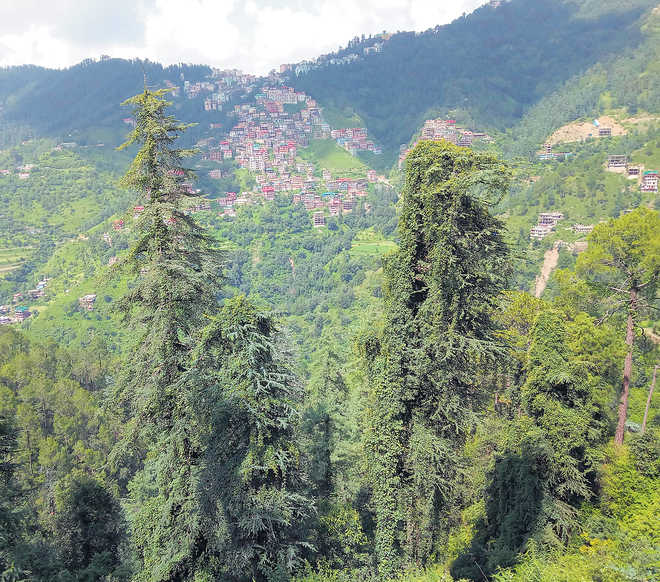Rakesh Lohumi
The spectacle of tall trees sheathed and festooned by giant climbers is becoming a common sight in Shimla and nearby forests. Pendulous vines hanging gracefully from the boughs enhance the aesthetics of forests and make a pleasant sight.
However, the uncontrolled spread of over-exuberant twining vines has now become a matter of concern. There are over 30 species of climbing vines and a few of them are indeed posing a threat to the trees. These fast-growing climbers are overwhelming one tree after the other. In some severely infested forests, a creeper heading upwards can be seen on the trunk of almost every tree. Completely overtaken, some trees appear like masts tied down to the ground by climbers.
The trees become vulnerable once their own foliage is overrun by the foliage of the climber. The process of photosynthesis is severely hindered, as they are deprived of sunlight. The victims are mostly the deodar trees. The Forest Department has identified three main species, Hedera helix, Vitis himalayan and Ficus sarmentosa, which are spreading fast. Hedera helix, which spirals around the trees in a strangulating embrace, affects them the most. The discontinuation of climber-cutting operations, which used to be a part of silvicultural operations to keep forests in good shape, has much to do with the alarming spread of tree climbers. Vine-infested trees grow rather slowly and, thus, their capacity for carbon sequestration declines.
But foresters are divided on “whether or not” to control the spread of vines. “The abundance of such creepers is not desirable, as they are not a natural associate of the deodar in forests. The problem is largely confined to urban forests, particularly in the Shimla area. Climbers have a debilitating effect on the trees and they should be contained to protect precious deodars,” asserts SP Vasudev, a former Principal Chief Conservator of Forests.
The urban forests have been depleting fast due to man-made factors like illegal felling of trees, dumping of debris and encroachments and that makes the new threat from aggressive climbers all the more significant.
However, GS Goraya, who retired as Principal Chief Conservator of Forests early this week, maintains that climbers are integral to the forest environment and should not be seen as a big threat. They do affect the structural quality of timber, but they are a part of the biodiversity and provide food for numerous bird and animal species.
There has been a change in the forest policy and the focus has shifted from timber to biodiversity. This was the main reason for the Forest Department not carrying out the climber-cutting operations. There is no need to take any control measures, as any such intervention will affect biodiversity, he explains.
A former director of the Himalayan Forest Research Institute (HFRI), Shimla, Surinder Kumar, called for a pragmatic approach to deal with the issue. The climbers growing and spreading faster than the trees was not a healthy situation. A rational policy should be adopted to serve the twin purpose of protecting the already- threatened trees and conserving the biodiversity. In the past, forest guards used to carry an axe to cut the climbers during inspection, he says.
Indeed, the uncontrolled spread of one marauding species can push some other more useful species to the brink. It is happening in many parts of the world and steps are being taken to eliminate what are often described as “strangulating vines”. Environmentalists see the ongoing climate change due to global warming as a possible reason behind the prolific growth of vines in the US and parts of Europe. Some recent studies on behavioural ecology of climbing plants have shown that climbers were growing at a very high rate.
Forest Minister Gobind Thakur said the department would conduct an in-depth study to look into various aspects of the problem and take a decision on its basis whether some policy intervention was required to control the tree climbers. Shimla owed its scenic splendour to the stately deodars and the government was committed to protect every tree.
The Forest Department was working on a plan to increase the forest cover in the capital town and it had already identified land for planting 1, 50,000 trees, out of which 70,000 would be planted on the land available with various government departments. The foundation of a nature park to be developed at a cost of Rs 1 crore in the Glen area, near Annandale, had already been laid.
Unlock Exclusive Insights with The Tribune Premium
Take your experience further with Premium access.
Thought-provoking Opinions, Expert Analysis, In-depth Insights and other Member Only Benefits
Already a Member? Sign In Now










